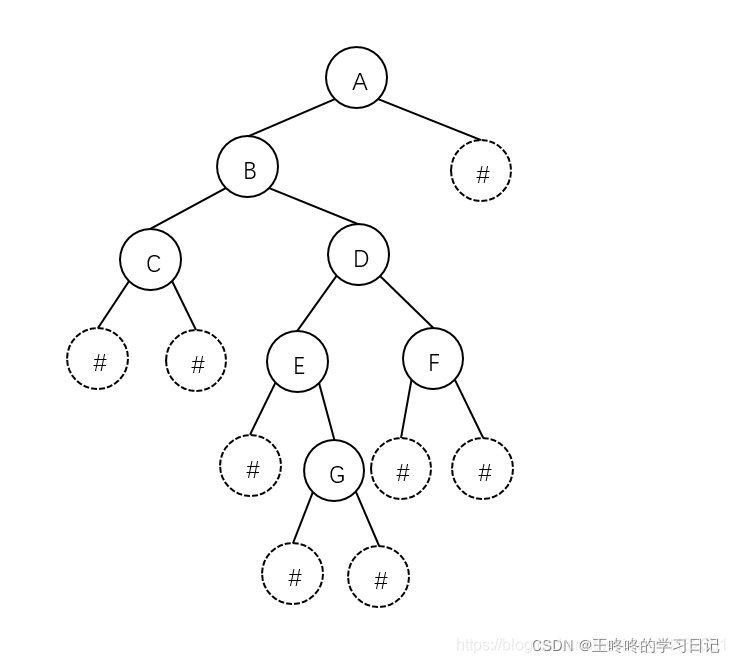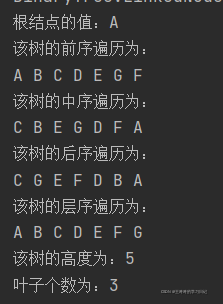在学习树的操作之后,我们就可以对数这种数据结构进行创建和使用了,话不多说,直接上代码
PS:为了代码复用和通用性,采用接口然后打包了整个工程,存储数据定义为泛型
一、接口及链结点定义
package BinaryTree;
public interface BinaryTreeInterface <T>{
public void preOrder(LinkedNode node);//前序遍历
public void inOrder(LinkedNode node);//中序遍历
public void postOrder(LinkedNode node);//后序遍历
public void levelOrder();//层序遍历
public int countHigh(LinkedNode node);//输出树高
public int countNum(LinkedNode node);//输出叶子结点个数
}结点采用链表的方式?
package BinaryTree;
public class LinkedNode<T> {
private LinkedNode<T> lChild;
private LinkedNode<T> rChild;
private T data;
LinkedNode<T> next;
public LinkedNode<T> getNext() {
return next;
}
public void setNext(LinkedNode<T> next) {
this.next = next;
}
public LinkedNode(T element){
data = element;
}
public LinkedNode<T> getlChild() {
return lChild;
}
public void setlChild(LinkedNode<T> lChild) {
this.lChild = lChild;
}
public LinkedNode<T> getrChild() {
return rChild;
}
public void setrChild(LinkedNode<T> rChild) {
this.rChild = rChild;
}
public T getData() {
return data;
}
public void setData(T data) {
this.data = data;
}
}
?
二、遍历
1.前序(递归)
@Override
public void preOrder(LinkedNode node){
if (node==null)
return;
else {
System.out.print(node.getData()+" ");
preOrder(node.getlChild());
preOrder(node.getrChild());
}
}2.中序(递归)
@Override
public void inOrder(LinkedNode node){
if (node==null)
return;
else {
inOrder(node.getlChild());
System.out.print(node.getData()+" ");
inOrder(node.getrChild());
}
}3.后序(递归)
@Override
public void postOrder(LinkedNode node){
if (node==null)
return;
else {
postOrder(node.getlChild());
postOrder(node.getrChild());
System.out.print(node.getData()+" ");
}
}?4.层序(队列)
这里多说一句,因为层序遍历的特性,采用队列的方式进行存储,所以我们这里提前定义一个队列类供其使用
package BinaryTree;
public class Queue<T> {
private LinkedNode<T> frist = null;
private LinkedNode<T> rear = null;
public boolean isEmpty(){
if(frist==null||rear==null)
return true;
return false;
}
public void enqueue(T element){
LinkedNode node = new LinkedNode(element);
if(isEmpty()){
frist = node;
rear = node;
}
else {
rear.setNext(node);
rear = node;
}
}
public T outqueue(){
if(isEmpty())
throw new NullPointerException("队列为空");
T ele = frist.getData();
frist = frist.getNext();
return ele;
}
}
@Override
public void levelOrder(){
Queue<LinkedNode> queue = new Queue<LinkedNode>();
if(root==null)
return;
else {
queue.enqueue(root);//抽象理解为将一颗树加入到这个队列中
while(!queue.isEmpty()){
LinkedNode tempNode = queue.outqueue();
System.out.print(tempNode.getData()+" ");
if(tempNode.getlChild()!=null)
queue.enqueue(tempNode.getlChild());
if (tempNode.getrChild()!=null)
queue.enqueue(tempNode.getrChild());
}
}
}三、创建二叉树(前序创建)
给定一个树的扩展序列(这里为前序)进行二叉树的创建,我们将虚结点定义为”#“
采用递归的方式进行创建
public void creatTree(T[] tree){
root = creatPreTree(tree);
}
private int elementCount = 0;
public LinkedNode<T> creatPreTree(T[] tree){
LinkedNode<T> node;
elementCount++;//索引值,到数组中每一个我们需要添加的点
if (elementCount > tree.length||tree[elementCount-1].equals("#"))
node = null;
else {
node = new LinkedNode<T>(tree[elementCount-1]);
node.setlChild(creatPreTree(tree));
node.setrChild(creatPreTree(tree));
}
return node;
}四、求树高(深度)、叶节点的个数
**还是递归**
@Override
public int countHigh(LinkedNode node){
if(node == null)
return 0;
else{
int lhight = countHigh(node.getlChild());
int rhight = countHigh(node.getrChild());
return Math.max(lhight,rhight)+1;
}
}
@Override
public int countNum(LinkedNode node){
if(node==null)
return 0;
if(node.getlChild()==null&&node.getrChild()==null){
return 1;
}
return countNum(node.getlChild())+countNum(node.getrChild());
}
最后
如这样一颗拓展二叉树

?
我们在主类中传入,输出它的遍历及深度、叶节点的个数验证代码
String[] str = {"A","B","C","#","#","D","E","#","G","#","#","F","#","#","#"};
?以上就是Java二叉树的相关操作,原创不易QAQ,如果对你有帮助的话点个赞再走吧 ~—~
欢迎评论区讨论~